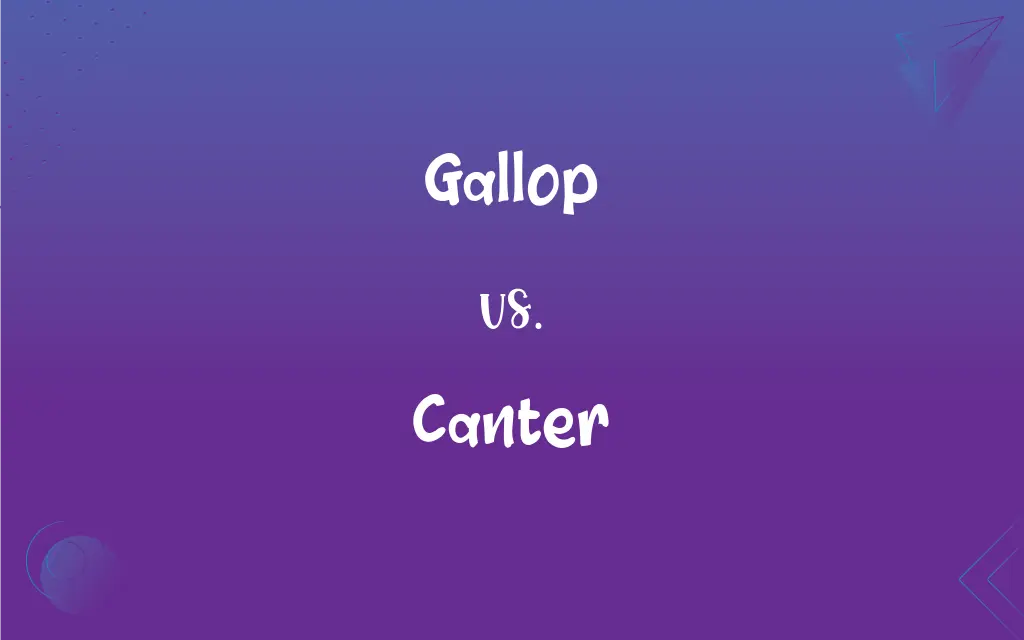Gallop vs. Canter: What's the Difference?
By Harlon Moss || Updated on May 30, 2024
Gallop is a fast, four-beat horse gait used for racing, while canter is a slower, three-beat gait ideal for casual riding and training.

Key Differences
Gallop is the fastest horse gait, characterized by a four-beat rhythm and a suspension phase where all four hooves are off the ground. It is commonly used in horse racing and is essential for covering ground quickly. Canter, on the other hand, is a moderate-speed, three-beat gait that is smoother and more controlled than a gallop. It is often used in dressage, show jumping, and casual riding due to its comfortable pace and balanced rhythm.
Galloping involves a sequence where each hoof hits the ground individually, resulting in a rapid and powerful motion. This gait is associated with speed and agility, making it ideal for competitive events and situations that require swift movement. In contrast, cantering has a more rhythmic and collected pattern, providing riders with a stable and manageable pace for various equestrian activities.
The speed difference between gallop and canter is significant. Galloping horses can reach speeds of 25-30 miles per hour, whereas cantering horses typically move at 10-17 miles per hour. This speed variance makes galloping less suitable for beginner riders, who may find it challenging to control the horse at such high speeds, whereas cantering offers a more accessible and less intimidating option.
Gallop is primarily associated with thoroughbred racing and other high-speed equestrian sports. Canter is more versatile, used in disciplines ranging from dressage to trail riding, making it a fundamental gait in equestrian training.
Comparison Chart
Speed
Fast, 25-30 mph
Moderate, 10-17 mph
ADVERTISEMENT
Rhythm
Four-beat
Three-beat
Suspension Phase
Yes, all four hooves off the ground
No, smoother transitions
Usage
Racing, short bursts
Dressage, show jumping, casual riding
Difficulty for Riders
High, requires skill and strength
Moderate, more controlled and accessible
Gallop and Canter Definitions
Gallop
The fastest gait of a horse, with four beats and a suspension phase.
The racehorse broke into a gallop as it neared the finish line.
ADVERTISEMENT
Canter
A gait that provides a balanced and manageable pace.
She preferred cantering for long trail rides.
Gallop
A high-speed, powerful movement used for racing and quick travel.
She watched the horses gallop across the field.
Canter
A moderate-speed, three-beat horse gait.
The rider guided the horse into a smooth canter.
Gallop
A swift, energetic pace that is difficult to maintain for long periods.
The cowboy's horse galloped away to chase the cattle.
Canter
A comfortable and controlled pace used in various equestrian disciplines.
They practiced cantering in the riding arena.
Gallop
A horse gait involving individual hoof impacts in rapid succession.
The rider urged the horse to gallop over the open terrain.
Canter
A rhythmic movement ideal for training and casual riding.
The horse cantered gracefully around the course.
Gallop
A gait of a horse, faster than a canter, in which all four feet are off the ground at the same time during each stride.
Canter
A smooth three-beat gait of a horse that is slower than a gallop but faster than a trot, in which the feet touch the ground in the three-beat sequence of near hind foot, off hind foot and near front foot, off front foot.
Gallop
A fast running motion of other quadrupeds.
Canter
A ride on a horse moving with this gait.
Gallop
A ride taken at a gallop.
Canter
To go or move at a canter.
Gallop
A rapid pace
Events were proceeding at a gallop.
Canter
To cause (a horse) to go at a canter.
Gallop
(Medicine) A disordered rhythm of the heart characterized by three or four distinct heart sounds in each cycle and resembling the sound of a galloping horse. Also called gallop rhythm.
Canter
A gait of a horse between a trot and a gallop, consisting of three beats and a "suspension" phase, where there are no feet on the ground. Also describing this gait on other four legged animals.
Gallop
To cause to gallop.
Canter
A ride on a horse at such speed.
Gallop
To go or move at a gallop.
Canter
One who cants or whines; a beggar.
Gallop
To move or progress swiftly
Summer was galloping by.
Canter
One who makes hypocritical pretensions to goodness; one who uses canting language.
Gallop
The fastest gait of a horse, a two-beat stride during which all four legs are off the ground simultaneously.
Canter
(intransitive) To move at such pace.
Gallop
An act or instance of going or running rapidly.
Canter
(transitive) To cause to move at a canter; to ride (a horse) at a canter.
Gallop
(cardiology) An abnormal rhythm of the heart, made up of three or four sounds, like a horse's gallop.
Canter
A moderate and easy gallop adapted to pleasure riding.
Gallop
To run at a gallop.
The horse galloped past the finishing line.
Canter
A rapid or easy passing over.
A rapid canter in the Times over all the topics.
Gallop
(intransitive) To ride at a galloping pace.
Canter
One who cants or whines; a beggar.
Gallop
(transitive) To cause to gallop.
To gallop a horse
Canter
One who makes hypocritical pretensions to goodness; one who uses canting language.
The day when he was a canter and a rebel.
Gallop
(ambitransitive) To make electrical or other utility lines sway and/or move up and down violently, usually due to a combination of high winds and ice accrual on the lines.
Canter
To move in a canter.
Gallop
(intransitive) To run very fast.
Canter
To cause, as a horse, to go at a canter; to ride (a horse) at a canter.
Gallop
To go rapidly or carelessly, as in making a hasty examination.
Canter
A smooth 3-beat gait; between a trot and a gallop
Gallop
To progress rapidly through the body.
Canter
Ride at a canter;
The men cantered away
Gallop
To move or run in the mode called a gallop; as a horse; to go at a gallop; to run or move with speed.
But gallop lively down the western hill.
Canter
Go at a canter, of horses
Gallop
To ride a horse at a gallop.
Canter
Ride at a cantering pace;
He cantered the horse across the meadow
Gallop
Fig.: To go rapidly or carelessly, as in making a hasty examination.
Such superficial ideas he may collect in galloping over it.
Canter
A steady gait that can be maintained for extended periods.
The horse's canter was perfect for the dressage routine.
Gallop
To cause to gallop.
Gallop
A mode of running by a quadruped, particularly by a horse, by lifting alternately the fore feet and the hind feet, in successive leaps or bounds.
Gallop
A fast gait of a horse; a two-beat stride during which all four legs are off the ground simultaneously
Gallop
Ride at a galloping pace;
He was galloping down the road
Gallop
Go at galloping speed;
The horse was galloping along
Gallop
Cause to move at full gallop;
Did you gallop the horse just now?
Gallop
A movement characterized by speed and agility.
During the hunt, the horses frequently galloped to keep up with the hounds.
FAQs
When is galloping used?
Galloping is used in horse racing and situations requiring fast, powerful movement.
How fast is a gallop?
Galloping horses can reach speeds of 25-30 miles per hour.
What is the rhythm of a gallop?
Gallop has a four-beat rhythm with each hoof hitting the ground individually.
Is galloping difficult for riders?
Yes, galloping requires skill and strength from the rider.
Is cantering suitable for beginners?
Yes, cantering is more accessible and manageable for beginners.
What is a gallop?
A gallop is the fastest horse gait, characterized by a four-beat rhythm and a suspension phase.
Can galloping be maintained for long periods?
No, galloping is typically used for short bursts of speed.
Can cantering be maintained for long periods?
Yes, cantering can be maintained for extended periods.
What is a canter?
A canter is a moderate-speed, three-beat gait that is smooth and controlled.
When is cantering used?
Cantering is used in dressage, show jumping, and casual riding.
Does cantering have a suspension phase?
No, cantering does not have a suspension phase, making transitions smoother.
What is the rhythm of a canter?
Canter has a three-beat rhythm that is smoother and more collected.
What type of activities is galloping associated with?
Galloping is associated with thoroughbred racing and high-speed equestrian sports.
Is galloping more strenuous for horses?
Yes, galloping requires significant energy and strength from the horse.
Why is galloping not recommended for beginners?
Galloping is fast and requires advanced riding skills, making it challenging for beginners.
Why is cantering recommended for training?
Cantering offers a controlled, balanced pace that is ideal for training and building riding skills.
How fast is a canter?
Cantering horses typically move at 10-17 miles per hour.
Does galloping have a suspension phase?
Yes, galloping includes a phase where all four hooves are off the ground.
What type of activities is cantering associated with?
Cantering is associated with dressage, show jumping, and trail riding.
Is cantering less strenuous for horses?
Yes, cantering is less strenuous and allows for longer durations of activity.
About Author
Written by
Harlon MossHarlon is a seasoned quality moderator and accomplished content writer for Difference Wiki. An alumnus of the prestigious University of California, he earned his degree in Computer Science. Leveraging his academic background, Harlon brings a meticulous and informed perspective to his work, ensuring content accuracy and excellence.
































































